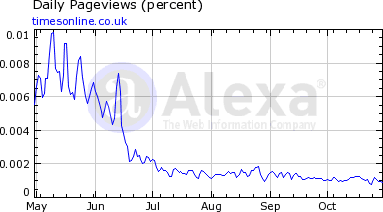Mac Musings
The Times Paywall Pays Off
Daniel Knight - 2010.11.02 -
Follow Low End Mac's blogs: LEMblog and Low End Mac Services.
Four months ago, Rupert Murdoch took The Times of London and The Sunday Times behind an electronic paywall. You can visit each site's homepage, but if you want to go any further, you're prevented from doing so until you subscribe.
![]()
Those who receive The Times or The Sunday Times by subscription have a free pass to these two websites. Others have a couple options:
- £1 (about US$1.60 today) for a 24 hour pass
- £1 for 30 days when you subscribe at £2 a week, which includes an iPad edition
As everyone expected, traffic to the Times website has plummeted from its previous level of over 21 million unique viewers per month to its homepage to 2.7 million per month at present, according to the BBC. That's an 87% drop on the homepage alone.
The Times says 105,000 people are paying to access its websites online, of which nearly half are subscribers and a bit over half pay for one-day access. Assuming the typical person buying a one-day pass visits the site once a month and using a four-week month to simplify calculation, we have 50,000 subscribers paying £8 a month and another 55,000 paying £1 to visit.
Based on these numbers, The Times is taking in approximately £455,000 (nearly US$730,000) per month from online subscribers. That sounds like a raging success.
Doing the Numbers
Prior to installing its paywall, over 20 million individuals visited the Times' websites every month - and the total number is probably a lot higher than that, since that's their statistic for unique visitors to the homepage alone. Still, it's a number.
If the Times were to use the traditional ad-based model and deliver free content, it could probably generate 0.5¢ per pageview, which is probably conservative for an organization as prestigious as The Times. 20 million times a half cent equals $100,000 (£62,500), and that's nothing compared to £455,000 a month.
But that's just the homepage, so it's far from the whole story.
 Alexa.com does a great job tracking
traffic to websites around the world; the graph to the right shows the
past six months of traffic to timesonline.co.uk. The graph shows daily
pageviews as a percentage of all Internet traffic, not raw pageview
numbers, but it's obvious that traffic dropped precipitously in
mid-June when the paywall went into effect.
Alexa.com does a great job tracking
traffic to websites around the world; the graph to the right shows the
past six months of traffic to timesonline.co.uk. The graph shows daily
pageviews as a percentage of all Internet traffic, not raw pageview
numbers, but it's obvious that traffic dropped precipitously in
mid-June when the paywall went into effect.
Let's conservatively say that the website served 12 times as many pages as it does today. If over 20 million people were visiting the homepage in May, based on typical website traffic patterns, we can assume that the homepage alone was served over 40 million times and that half of visitors to the homepage clicked through to another article, bringing traffic to 60 million pages per month.
But that doesn't take direct links to other pages into account. If Low End Mac is typical (and I have no idea if that is the case), total pageviews are perhaps five times the number of hits on the homepage, which means that traffic to timesonline.co.uk could have been in the ballpark of 100 million page views per month.
Instead of perhaps $100,000 per month, based on 20 million unique visitors to the site's homepage, we're looking at $500,000 (£312,500) per month.
And that's just for the main website. Sunday Times traffic has grown significantly since May, according to Alexa. Still, it's only about one-fifth as high as the main Times website. Figure that could bring in another $100,000 (£62,500) per month, and we have an estimated monthly income for the two sites of $600,000 (£375,000).
Is This Success?
Based on our guesses, the paywall could be generating more income than ads would have.
We're making some educated guesses here. It's possible that ads could generate a penny per pageview - or one-tenth that - which could mean that the ad-based free content model may be more profitable, or far less profitable.
There may also be a savings in hosting and Internet access fees for the Times, as one-twelfth as many pages served means a lot less bandwidth used. This would also mean a better bottom line for the paywall.
Only those who have access to the Times' financial information know for sure, but based on our seat-of-my-pants estimates, the paywall appears to be a valid business model for the Times.
Rupert Murdoch said that his news sites have value and that people are willing to pay to access it. At least in the case of the Times, he proved his point.
There's an interesting parallel to Apple here. Murdoch has taken a premium brand, priced it higher than the competition (most of which is free), and is turning a profit from a much smaller segment of the market than it would have with lower prices and less profits per sale.
Join us on Facebook, follow us on Twitter or Google+, or subscribe to our RSS news feed
Dan Knight has been using Macs since 1986, sold Macs for several years, supported them for many more years, and has been publishing Low End Mac since April 1997. If you find Dan's articles helpful, please consider making a donation to his tip jar.
Links for the Day
- Mac of the Day: 15" PowerBook G4 (Late 2003), introduced 2003.09.16. The 15" PowerBook moved to aluminum, gaining FireWire 800 and AirPort Extreme.
- Support Low End Mac